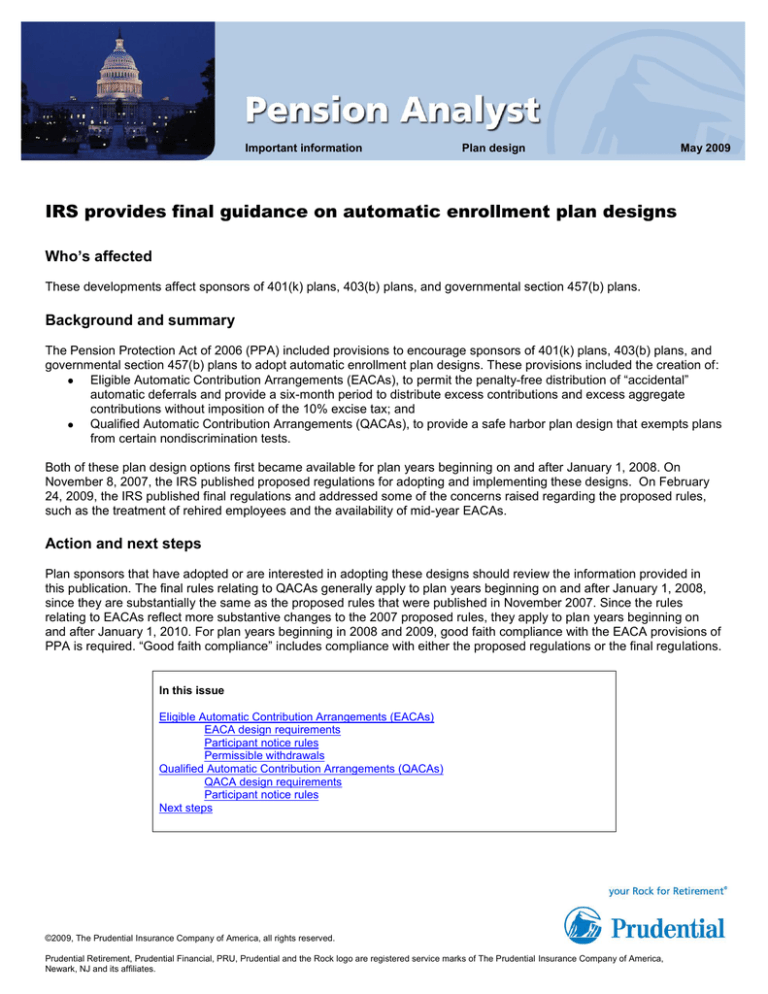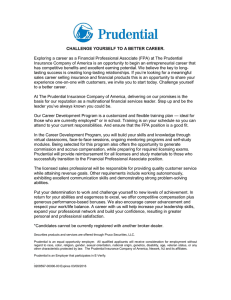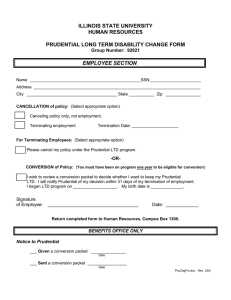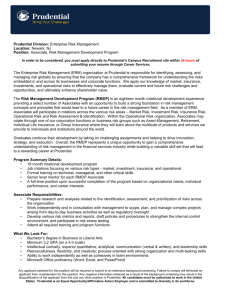
Important information
Plan design
May 2009
IRS provides final guidance on automatic enrollment plan designs
Who’s affected
These developments affect sponsors of 401(k) plans, 403(b) plans, and governmental section 457(b) plans.
Background and summary
The Pension Protection Act of 2006 (PPA) included provisions to encourage sponsors of 401(k) plans, 403(b) plans, and
governmental section 457(b) plans to adopt automatic enrollment plan designs. These provisions included the creation of:
Eligible Automatic Contribution Arrangements (EACAs), to permit the penalty-free distribution of “accidental”
automatic deferrals and provide a six-month period to distribute excess contributions and excess aggregate
contributions without imposition of the 10% excise tax; and
Qualified Automatic Contribution Arrangements (QACAs), to provide a safe harbor plan design that exempts plans
from certain nondiscrimination tests.
Both of these plan design options first became available for plan years beginning on and after January 1, 2008. On
November 8, 2007, the IRS published proposed regulations for adopting and implementing these designs. On February
24, 2009, the IRS published final regulations and addressed some of the concerns raised regarding the proposed rules,
such as the treatment of rehired employees and the availability of mid-year EACAs.
Action and next steps
Plan sponsors that have adopted or are interested in adopting these designs should review the information provided in
this publication. The final rules relating to QACAs generally apply to plan years beginning on and after January 1, 2008,
since they are substantially the same as the proposed rules that were published in November 2007. Since the rules
relating to EACAs reflect more substantive changes to the 2007 proposed rules, they apply to plan years beginning on
and after January 1, 2010. For plan years beginning in 2008 and 2009, good faith compliance with the EACA provisions of
PPA is required. “Good faith compliance” includes compliance with either the proposed regulations or the final regulations.
In this issue
Eligible Automatic Contribution Arrangements (EACAs)
EACA design requirements
Participant notice rules
Permissible withdrawals
Qualified Automatic Contribution Arrangements (QACAs)
QACA design requirements
Participant notice rules
Next steps
©2009, The Prudential Insurance Company of America, all rights reserved.
Prudential Retirement, Prudential Financial, PRU, Prudential and the Rock logo are registered service marks of The Prudential Insurance Company of America,
Newark, NJ and its affiliates.
May 2009
Eligible Automatic Contribution Arrangements (EACAs)
An EACA is an automatic enrollment arrangement that is exempt from some of the standard distribution restrictions that
apply to 401(k) plans, 403(b) plans, and governmental section 457(b) plans. An EACA may:
Distribute automatic contributions made to the plan within 90 days of the effective date of a participant’s first
automatic contribution, regardless of the participant’s age or ability to take standard in-service distributions (these
are called “permissible withdrawals”); and
Distribute excess contributions and excess aggregate contributions to correct failed ADP and ACP tests within six
months of the end of the plan year without subjecting the employer to a 10% excise tax.
An EACA is not required to reflect both of these special provisions. For example, an EACA that is also a QACA has no
need for the six-month extended correction distribution period.
EACA design requirements
An automatic enrollment arrangement can be an EACA if it:
Provides for deferral contributions to be made automatically at a specified percentage of compensation, unless a
participant specifically elects not to participate or elects a different deferral rate; and
Provides advance notice of the automatic contribution arrangement to all affected participants.
Under PPA, an EACA was also required to invest automatic deferrals and related employer contributions in a qualified
default investment alternative (QDIA) and provide the required QDIA notice. The Worker, Retiree, and Employer Recovery
Act of 2008 (WRERA), which President Bush signed into law on December 23, 2008, removed this QDIA requirement
retroactively for plan years beginning on and after January 1, 2008. The IRS final regulations recognize the elimination of
this requirement and do not require EACAs to provide QDIAs.
The automatic contribution percentage provided by an EACA must be a uniform percentage of compensation. However,
plans may automatically increase the default deferral percentage in later years of participation. In addition, the final rules
allow a single plan to offer multiple EACAs, covering different groups of employees. In general, if a plan offers multiple
EACAs, the EACAs must be aggregated for purposes of complying with the uniformity requirement, with the exception of
EACAs that cover employees who must or may be disaggregated for purposes of minimum coverage testing. As a result,
a single plan can provide separate EACAs, providing different automatic contribution percentages to:
Collectively-bargained employees and non-collectively-bargained employees;
Different groups of collectively-bargained employees; or
In the case of a multiple employer plan, to employees of different employers.
In fact, the final rules allow plans to apply EACA provisions to only some of their eligible employees. Naturally, the plan
document must specify which employees are covered by the EACA (or EACAs). The plan document must also state
whether an employee who makes an affirmative election remains covered by the EACA. This is an important requirement
because this aspect of plan design will determine which employees need to receive annual participant notices. If
employees who make affirmative elections to participate or not to participate are no longer covered by an EACA, they do
not need to receive annual notices. However, if all eligible employees under a plan are not covered by EACAs, the plan
cannot take advantage of the extended six-month ADP and ACP corrective distribution deadline.
The final rules also clarify one very important aspect of EACA design that was not clear in the rules that were proposed in
2007. Specifically, a plan sponsor may not adopt an EACA mid-plan year. An EACA must be in place for an entire plan
year. As a result, the plan sponsor must adopt the appropriate plan provisions and notify participants about the plan
design before the start of the first plan year it is to be in effect.
Participant notice rules
In addition to clarifying who must receive the required participant notices, the final rules provide a great deal of guidance
about notice timing, content and delivery.
Recipients. In general, initial and annual notices must be provided to all employees who are covered by an EACA. If a
plan provides multiple EACAs covering different groups of employees, different notices may be needed for each group. If
a plan provides that employees who make affirmative elections are no longer covered by the EACA, those employees do
not need to receive annual notices.
©2009, The Prudential Insurance Company of America, all rights reserved.
Prudential Retirement, Prudential Financial, PRU, Prudential and the Rock logo are registered service marks of The Prudential Insurance Company of America, Newark, NJ and its affiliates.
2
May 2009
Timing. An initial participant notice must be provided “within a reasonable period” before an employee becomes eligible to
participate in an EACA. Annual notices must be provided to employees who remain covered by the EACA “within a
reasonable period” before the beginning of each plan year. Employees must have a reasonable period of time after
receiving either notice to elect not to participate or to make a different level of contribution.
A newly-eligible employee is deemed to be given the initial notice within a reasonable period if it is provided no later than
the date he becomes an eligible employee. If it is not possible to provide the initial notice on or before the date the
employee becomes eligible for the EACA, the notice must be provided as soon as possible after that date and the
employee must be able to defer from all types of compensation that may be deferred under the plan beginning on his
initial date of eligibility. Essentially, this means that the notice must be provided no later than the pay date of the payroll
period that includes the employee’s initial eligibility date.
Annual notices are deemed to be given within a reasonable period if they are provided at least 30 days and no more than
90 days before the beginning of each plan year.
Content. Participant notices must be written in a manner calculated to be understood by the average employee who is
subject to the arrangement. These notices must include the following information:
The level of default elective contributions that will be made if the employee does not make an affirmative election;
The employee’s right to make a different deferral election;
How to make deferral elections, including any administrative requirements that apply;
The periods available for making deferral elections;
The type and amount of compensation that may deferred;
How default contributions will be invested if the employee does not make an investment election;
The types of employer contributions made under the plan and the eligibility requirements for receiving these
contributions;
The vesting and withdrawal provisions for the various types of plan contributions;
If applicable, the availability of permissible withdrawals and the procedures for requesting one; and
How to obtain additional information about the plan.
These content requirements cannot be satisfied by simply cross-referencing the summary plan description (SPD). If an
EACA uses a QDIA for default investments, the plan may provide employees with a combined EACA/QDIA notice.
Similarly, an EACA that is also a QACA may provide a combined EACA/QACA notice. Sample notices are available on
the IRS website.
Delivery. Plan sponsors may provide these notices in writing or deliver them electronically, in accordance with the IRS
electronic media rules.
Permissible withdrawals
Even with advance notification and a reasonable period of time to decline participation, some employees do not
understand the impact of the automatic deferral provision until the first deferrals are deducted from their paychecks. An
EACA may provide a special distribution option that allows participants to receive refunds of “accidental” automatic
contributions made within 90 days following the date the first automatic contribution was made. PPA and IRS regulations
refer to these distributions as “permissible withdrawals.” The amount of this distribution will be included in the participant’s
gross income in the year the distribution is made, but will not be subject to the 10% excise tax on early withdrawals,
regardless of the participant’s age. Any employer matching contribution made on account of the distributed deferrals must
be forfeited.
Eligibility. Permissible withdrawals are only available for contributions made on or after January 1, 2008. In addition, a
plan may make this provision available to all employees or to just certain groups of employees (for example, to employees
for whom no contributions were made before the EACA effective date). However, a plan may not condition the right to
take advantage of this provision on the employee making an election to make no further elective contributions.
Timing. The 90-day window for electing a permissible withdrawal begins on the date the deferred compensation would
otherwise have been includible in the participant’s gross income. In general, this would be the first pay date on which
deferral contributions were made. The election to take a withdrawal must be effective no later than the earlier of (a) the
pay date for the second payroll period beginning after the date the election is made; or (b) the first pay date occurring at
least 30 days after the election is made, The effective date is essentially the end-date for determining the amount to be
distributed as a permissible withdrawal.
©2009, The Prudential Insurance Company of America, all rights reserved.
Prudential Retirement, Prudential Financial, PRU, Prudential and the Rock logo are registered service marks of The Prudential Insurance Company of America, Newark, NJ and its affiliates.
3
May 2009
For example: XYZ Company has biweekly payroll periods. Frank is an employee of XYZ Company and has his first
automatic contributions deferred from his April 3, 2009 paycheck. He must make an election to take a permissible
withdrawal no later than July 2, 2009. If he makes the election on May 1, 2009, it must be effective no later than the
earlier of May 29, 2009 (the pay date for the second pay period beginning after May 1), or June 12, 2009 (the first pay
date occurring at least 30 days after the election is made). As a result, his permissible withdrawal may only include
deferrals and earnings through May 29, 2009. If any deferrals are taken from his pay after May 29, they must remain
in the plan until another distributable event occurs.
In response to commentators’ concerns that the 90-day deadline would be difficult to monitor and could accidentally be
missed, the final rules allow plans to limit the election period to less than 90 days. However, the election period must be at
least 30 days. Similarly, plans may specify an effective date for these withdrawals that is earlier than the deadline
described above.
If a plan provides multiple EACAs that are aggregated to satisfy the uniformity requirement, an employee’s 90-day
withdrawal window is measured from the date the first automatic contributions are made for him to any EACA under the
plan. If a plan provides multiple disaggregated EACAs, separate 90-day windows may be applied to each EACA.
The final rules do not provide a specific deadline for making permissible withdrawal distributions. Instead, they note that
these distributions are subject to the plan’s standard rules regarding distribution processing and timing.
Amount, taxability and treatment under other plan rules. The amount distributed is the amount of the default
contributions made to the plan, adjusted for gains and losses, and may be reduced by any applicable fees (such as a
check processing fee). A plan may charge a lower processing fee for these withdrawals than it does for other types of
distributions, but may not charge a higher fee. Pre-tax contributions are taxable in the year distributed, but designated
Roth contributions are not taxed twice. Permissible withdrawals are reported on Form 1099-R, are not subject to the 10%
early distribution penalty tax, and are not eligible rollover distributions, In addition, permissible withdrawals are
disregarded when performing the ADP test and applying the annual deferral limit.
Related matching contributions. In general, any matching contributions related to distributed default contributions must
be forfeited, and treated in the same manner as any other forfeitures under the terms of the plan. The rules clearly state
that these matching contributions cannot be returned to the employer as erroneous or mistaken contributions. However,
the final rules do allow plans to provide that matching contributions will not be made if a permissible withdrawal is taken
before the date the matching contributions would have been allocated.
Treatment of rehired employees. One notable area of concern reflected in the comments submitted to the IRS regarding
the proposed regulations was how to apply the permissible withdrawal rules to rehired employees. The final regulations
provide special rules regarding the treatment of periods without default contributions, which apply to rehired employees as
well as to certain other situations. This special rule allows, but does not require, plans to treat an employee who did not
have default contributions made for an entire plan year as a new employee.
For example: The ABC Company’s 401(k) Plan has a calendar plan year. Effective January 1, 2008, ABC
Company adopts an EACA design to allow permissible withdrawals. Mike had default deferral contributions made
to the Plan in 2008 but terminated employment with ABC Company on August 1, 2008. ABC Company rehires
Mike on February 1, 2010. Since Mike did not have any default contributions made to the ABC Company 401(k)
Plan at any time during the 2009 plan year, the Plan may treat Mike as a new employee. As a result, if Mike is
automatically enrolled but decides he does not want to make deferral contributions, he may request a permissible
withdrawal within 90 days of his automatic re-enrollment.
If ABC Company rehires Mike at any time in 2009 and he is automatically enrolled, he cannot request a
permissible withdrawal of his default deferral contributions.
Qualified Automatic Contribution Arrangements (QACAs)
A QACA is a 401(k) or 403(b) automatic enrollment arrangement that is not subject to ADP Testing, ACP Testing, or TopHeavy Testing. To be a QACA, an automatic contribution arrangement must provide a specified schedule of automatic
contributions, an employer contribution, and notices to participants describing the plan provisions. The QACA design is
essentially a variation on the original ADP Safe Harbor design introduced by the Small Business Job Protection Act of
1996 (SBJPA), which can provide either affirmative enrollment or automatic enrollment.
©2009, The Prudential Insurance Company of America, all rights reserved.
Prudential Retirement, Prudential Financial, PRU, Prudential and the Rock logo are registered service marks of The Prudential Insurance Company of America, Newark, NJ and its affiliates.
4
May 2009
In general, a QACA must be in effect for an entire 12-month plan year. A QACA may not be adopted mid-plan year and
may be suspended mid-plan year only in limited circumstances. The appropriate plan provisions must be adopted before
the first day of the first plan year for which the QACA design is to be effective and initial participant notices must be
provided before the effective date of the QACA. A plan may apply the QACA design to only some of the eligible
employees by applying the minimum coverage testing disaggregation rules.
QACA design requirements
Automatic deferral contributions. A QACA must provide for deferral contributions to be made automatically at specified
percentages of compensation, unless a participant specifically elects not to participate or elects a different deferral rate.
The minimum required deferral amount increases following a participant’s initial period of participation (automatic
escalation), but automatic deferrals may never exceed 10% of compensation. The minimum required automatic deferrals
are as follows:
Period of Participation
Initial Period
(i.e., through the end of the 1st
plan year beginning after the
date the first automatic contribution
is made for the participant)
Second Plan Year
Third Plan Year
All Later Plan Years
Minimum Deferral Percentage
3% of Compensation
4% of Compensation
5% of Compensation
6% of Compensation
In general, these automatic deferral requirements must apply to all eligible employees. However, they do not have to be
applied to employees who already had a deferral election or an affirmative election not to participate in place immediately
before the date the plan adopts these provisions. This exception applies only if an employee has completed an election
form and chosen an amount or percentage (including zero) of his compensation to be deferred.
A QACA may provide higher automatic deferral percentages than the required minimum percentages. If it does so, it does
not necessarily have to increase later percentages as long as they meet the minimum percentage requirements. For
example, a plan that provides a 4% contribution during the initial period (rather than the required 3%) may continue to
provide a 4% contribution in the second year since that is the minimum percentage for that year, but would have to
increase to 5% for the third year. The final rules also confirm that a QACA may provide for scheduled deferral increases
to occur earlier than required by law. As a result, deferral increases may be timed to coincide with salary increases.
A plan may suspend automatic contributions during a six-month suspension period following a hardship withdrawal.
However, when the suspension ends, the participant’s contributions must resume at the level that would apply if he had
not been suspended.
The final rules confirm that a plan may provide that affirmative elections expire (for example, at the end of the plan year)
and require employees to make new affirmative elections if they want to continue the prior rate of elective contributions.
With this design, an eligible employee who does not make a new affirmative election is automatically enrolled at the
appropriate level based on the number of years since the date he was first automatically enrolled under the QACA.
Compensation used for determining deferrals and employer contributions must be safe harbor compensation. The final
rules clarify that for plan years beginning on or after January 1, 2010, the compensation used for non-highly compensated
employees may not be limited to a specific amount.
Required employer contributions. In addition to the automatic deferral contributions, the employer must make for each
eligible non-highly compensated employee either:
A nonelective contribution equal to at least 3% of compensation; or
A matching contribution that matches 100% of the first 1% of compensation deferred and 50% of deferrals that
exceed 1% of compensation, with no match on deferrals exceeding 6% of compensation. Alternatively, the plan
may provide an enhanced matching formula that results in matching contributions that are at least equal to the
amount required under the standard matching formula, with a rate that does not increase as the employee’s rate
of deferral contributions increases. To avoid ACP testing, no matching contribution may be made on deferrals
exceeding 6% of compensation.
©2009, The Prudential Insurance Company of America, all rights reserved.
Prudential Retirement, Prudential Financial, PRU, Prudential and the Rock logo are registered service marks of The Prudential Insurance Company of America, Newark, NJ and its affiliates.
5
May 2009
These “safe harbor” employer contributions may only be distributed when the participant reaches age 59½, dies, becomes
disabled, or terminates employment. They are not eligible for hardship withdrawal. In addition, participants must be 100%
vested in these contributions after they complete two years of service.
Treatment of rehired employees. In response to the comments submitted regarding the proposed regulations, the final
regulations provide special rules regarding the treatment of periods without default contributions. These rules allow, but do
not require, plans to treat an employee who did not have default contributions made for an entire plan year as a new
employee. If a plan applies this rule, certain rehired employees would have automatic contributions made at the initial
level specified under the plan. Other rehired employees would have automatic contributions made at the levels
determined by their initial dates of automatic enrollment.
Participant notice rules
Recipients. QACAs must provide both initial and annual participant notices to all eligible employees, including employees
who are not automatically enrolled. If a plan contains both EACA and QACA provisions, the employee populations that
must receive the required notices may be very different, since EACA notices must only be provided to employees who are
covered by the EACA.
Timing. An initial participant notice must be provided “within a reasonable period” before an employee becomes eligible to
participate in a QACA. Annual notices must be provided to all eligible employees “within a reasonable period” before the
beginning of each plan year. Employees must have a reasonable period of time after receiving either notice to elect not to
participate or to make a different level of contribution.
A newly-eligible employee is deemed to be given the initial notice within a reasonable period if it is provided no later than
the date he becomes an eligible employee. If it is not possible to provide the initial notice on or before the date the
employee becomes eligible for the QACA, the notice must be provided as soon as possible after that date and the
employee must be able to defer from all types of compensation that may be deferred under the plan beginning on his
initial date of eligibility. Essentially, this means that the notice must be provided no later than the pay date of the payroll
period that includes the employee’s initial eligibility date.
Annual notices are deemed to be given within a reasonable period if they are provided at least 30 days and no more than
90 days before the beginning of each plan year.
Content. Participant notices must be written in a manner calculated to be understood by the average employee who is
subject to the arrangement. These notices must include the following information:
The level of default elective contributions that will be made if the employee does not make an affirmative election;
The employee’s right to make a different deferral election;
How to make deferral elections, including any administrative requirements that apply;
The periods available for making deferral elections;
The type and amount of compensation that may be deferred;
How default contributions will be invested if the employee does not make an investment election;
The safe harbor employer contribution made to the plan, including the schedule of matching contributions, if
applicable;
The plan to which safe harbor contributions will be made, if this is not the plan to which the deferral contributions
are made;
The types of other employer contributions made under the plan and the eligibility requirements for receiving these
contributions;
The vesting and withdrawal provisions for the various types of plan contributions; and
How to obtain additional information about the plan.
In general, these content requirements cannot be satisfied by simply cross-referencing the SPD. However, the notice may
cross-reference the portions of an SPD that describe: the type and amount of compensation that may be deferred; the
plan to which safe harbor contributions will be made, if not the same plan; and the types of other employer contributions
made to the plan. In addition, plans may provide employees with a combined QACA/EACA/QDIA notice. Sample notices
are available on the IRS website.
Delivery. Plan sponsors may provide these notices in writing or deliver them electronically, in accordance with the IRS
electronic media rules.
©2009, The Prudential Insurance Company of America, all rights reserved.
Prudential Retirement, Prudential Financial, PRU, Prudential and the Rock logo are registered service marks of The Prudential Insurance Company of America, Newark, NJ and its affiliates.
6
May 2009
Next steps
Plan sponsors that have already adopted EACA or QACA provisions should review these final regulations to identify
changes that must be made to their plan designs. In addition, they should identify new design options, such as those that
apply to rehired employees, which they may want to adopt. If you are interested in adopting one or both of these designs,
or in adopting any of the new design options for an existing EACA or QACA, you should contact your Prudential
Retirement representative or Financial Advisor for assistance in evaluating the plan design that best meets your needs
and the related implementation services that Prudential can provide.
Pension Analyst by Prudential Retirement
The Pension Analyst is published by Prudential Retirement, a Prudential Financial business, to provide clients with information on current legislation and
regulatory developments affecting qualified retirement plans. This publication is distributed with the understanding that Prudential Retirement is not
rendering legal advice. Plan sponsors should consult their attorneys about the application of any law to their retirement plans.
Editor: Mitzi Romano
(860) 534-2768
©2009, The Prudential Insurance Company of America, all rights reserved.
Prudential Retirement, Prudential Financial, PRU, Prudential and the Rock logo are registered service marks of The Prudential Insurance Company of America, Newark, NJ and its affiliates.
7




